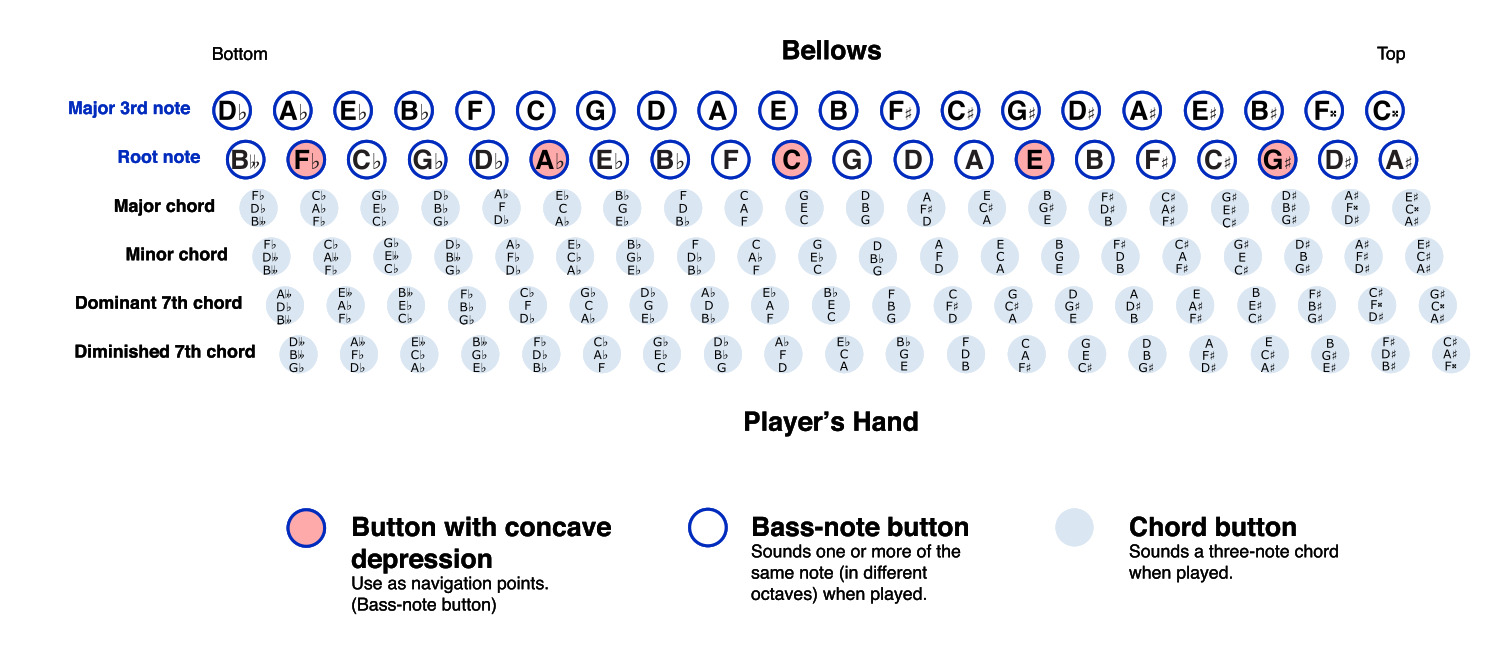Major 7th Chords

Above image from https://en.wikipedia.org/wiki/Stradella_bass_system
The Stradella bass accordion can play a lot of chord types, but many are not all that obvious. In this article we will discuss the “major 7th chord”. To differentiate this from the dominant 7 we use “7” to specify dominant and “M7” for major 7.
A bit of theory and a note about Stradella basses: When you press the buttons labeled “7” you are playing what we call a dominant 7th chord. Don't worry too much if you don't understand all this, but when playing a chord it's all based on some pretty basic chord theory. A “C Major” chord requires the first, third and fifth notes in a major scale. And, as expected the C major button (abbreviated CM) located in the third row from the bellows gets you a C, E and G. A EM is E, G# and A. We'll leave it to ask your music teacher the really hard questions! A C7 is played in the fifth row. In this case it should be C, E, G and Bb; E7 should be E, G#, A and D.
But, above we just said “should be.” So, now, a bit of Stradella trickery. When playing 7th chords the fifth is omitted. There are a number of reasons for this ... and they really serve to make your life much easier! So, for the C7th chord the G is omitted; for the E7 it is the A. You might think this takes liberty with what the chord should sound like, but trust me: it's fine. And if you really want to add the missing note it's simple: For C7 you press the 7 button and the G in the next column.
Ahh, okay. But what is this “major 7” stuff? Well, again, it's pretty simple: For our CM7 example we want the notes C, E, G and B and for EM7 we get E, G#, A and D#.
Since the 7th tone (major or dominant) is often repeated in the melody or harmony, my rule is to think about conflicts. If you are playing a B note and and C7 chord it will sound “off”. This is probably not something you need to worry about with dominant chords, but with major 7ths you really do. Playing a C7 against a Bb is a common mistake.
There are a number of ways to avoid the problem:
- Simplest is to forget about the 7 altogether and play a major chord (row 3). Not the most elegant, but it works for both dominant and major 7 chords.
- Play the minor chord associated with the 3rd degree of the chord. So, for a CM7 you can play an Em chord. The notes in this chord are E, G and B. To get all the notes, just add in the C from row 2. I, personally, don't like this solution. To my ear it makes the chord louder (4 notes, instead of 3); and (most importantly) I don't find it comfortable or intuitive for fingering patterns.
- My method? I play a major chord (simple third row) and add the major 7 by pressing the counter bass button in the next row. In the case of CM7 I play C, E and G via the major chord button and the seventh (a B) by pressing the counter bass button above G. The beauty of this method, apart from being simple and intuitive, is that you now have the start of a very nice bass run.
To avoid the heavy sounding chords resulting from 4 notes instead of 3, I suggest you don't play the major tone (a C) from item 2 or the M7 tone (a B) in item 3. Use them as your bass notes and use the chord on the off-beats.
 |
This page was last modified on 2024-08-16 |